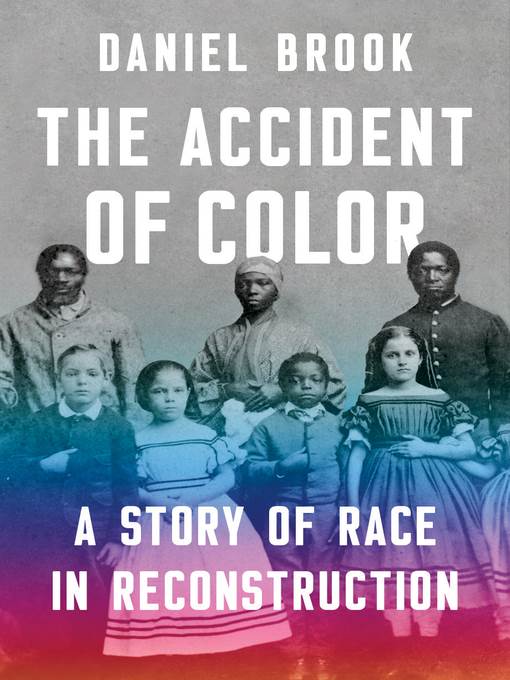
The Accident of Color
A Story of Race in Reconstruction
کتاب های مرتبط
- اطلاعات
- نقد و بررسی
- دیدگاه کاربران
نقد و بررسی

Before the Civil War, free biracial people held many citizenship rights in New Orleans and Charleston, SC. Afterward, they joined with the formerly enslaved to fight for rights (e.g., the desegregation of streetcars and schools) eventually wiped out by Jim Crow. Chronicling the first civil rights movement.
Copyright 1 Library Journal, LLC Used with permission.
April 15, 2019
Illuminating investigation of the historical binaries of race in America. Before American independence, writes freelance journalist Brook, places such as Charleston and New Orleans turned on the assumption that "in the New World there was precious little racial purity" and that naturally and inevitably, people who came from far-flung ethnic groups would meet and intermingle. After independence, however, that changed: The official appointed to govern New Orleans after the Louisiana Purchase, for instance, quietly instituted procedures to limit the rights of supposedly nonwhite citizens even if, as a later activist who pressed for the rights of all citizens no matter what their ethnic composition noted, "if you were not informed you would be sure to pick out the white for colored & the colored for white." Free, mixed-race communities in those cosmopolitan cities had long flourished, even if they were anomalous elsewhere. It outraged nativists, notes the author, that immigrants from Europe who arrived in the 19th century treated everyone they encountered as equals. Yet this equality was fleeting. South Carolina Reconstruction-era congressman Joseph Hayne Rainey observed in a speech before the House that in Charleston he could enjoy public amenities while in Washington, he was denied "the same benefits that are accorded to our white colleagues on this floor." Things would only get worse for Rainey and others now classified as black in the postwar binary of race through the mechanism of Jim Crow laws throughout the country. The very idea of "black" and "white," Brook ably demonstrates, is the product of segregation: "It is only because mixed-race activists failed, despite their valiant efforts, to stop a regime of race-based rights that contemporary Americans view society through the racial blinders that we do." In his fluent narrative, the author shows how much we have lost by denying the reality that "we are mestizos, Creoles, misfits all." A provocative, welcome contribution to ethnic studies and the literature of civil rights.
COPYRIGHT(2019) Kirkus Reviews, ALL RIGHTS RESERVED.

May 20, 2019
The phrase “civil rights movement” is usually associated with the 1950s and 1960s, but, as journalist Brook’s insightful history shows, it is just as appropriately applied to the post–Civil War era. People of mixed racial heritage from Charleston and New Orleans, “misfit metropolises” that were home to sizable communities of free people of color, hoped to help the millions of ex-slaves, but were also concerned with protecting their own relatively privileged positions in the face of a new concept of race. That was the “one-drop rule,” according to which every American was either white or black, with no difference between “freemen and freedmen, wine merchants and cotton pickers.” Brook skillfully sketches the struggles of such men and women as Charles St. Albin Sauvinet, who battled educational inequalities in post–Civil War New Orleans, and Josephine DeCuir, who in 1873 successfully sued the steamboat company that would not honor her first-class ticket, an instance that showed how quickly post–Civil War racial advances were lost to Jim Crow segregation. Brook points out that later advances, such as the ruling in Brown v. Board of Education, were based on the idea that individuals could and should be assigned unitary racial identities. Brook reminds readers that binary conceptions of race are relatively recent historical artifacts, and that the first post–Civil War civil rights movement rejected not just racism but race itself. This thoughtful and vivid history makes a valuable contribution to the understanding of race in America.

June 1, 2019
Brook presents a well-researched, fresh, and sometimes funny social history of how biracial Americans in nineteenth-century New Orleans and Charleston, South Carolina, pragmatically created a lane for themselves between the white establishment and Black margins. They intermarried, formed social groups like the Browns and legal societies such as Comite des Citoyens, and petitioned for rights specifically for biracial people. Brook tells the stories of individuals who resisted political subjugation, like Confederate soldier Pierre Beauregard, and Homer Plessy, the Rosa Parks of the Reconstruction era. Biracial Americans pressured governors, senators, and presidents during Reconstruction and, ultimately, impacted the armed forces, Lincoln's Republican Party, and state colleges and public schools. Vestiges of either-or racial thinking remain today, however, impeding social progress. Brook's coda that we are mestizos, Creoles, misfits all, affirms W. E. B. DuBois's pessimistic view of the centrality of the color question and echoes Ralph Ellison's ironic notion that whatever else America is, she is also somehow black. Brook challenges others to view America through a sepia lens and reassert the value of discussing America's pluralism.(Reprinted with permission of Booklist, copyright 2019, American Library Association.)

























دیدگاه کاربران